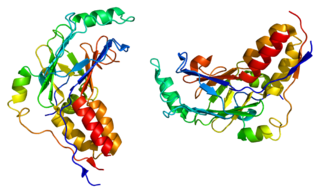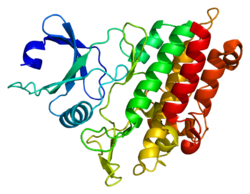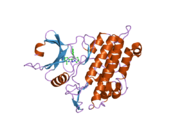
Mothers against decapentaplegic homolog 2 also known as SMAD family member 2 or SMAD2 is a protein that in humans is encoded by the SMAD2 gene. MAD homolog 2 belongs to the SMAD, a family of proteins similar to the gene products of the Drosophila gene 'mothers against decapentaplegic' (Mad) and the C. elegans gene Sma. SMAD proteins are signal transducers and transcriptional modulators that mediate multiple signaling pathways.

SMAD family member 6, also known as SMAD6, is a protein that in humans is encoded by the SMAD6 gene.

Mothers against decapentaplegic homolog 7 or SMAD7 is a protein that in humans is encoded by the SMAD7 gene.
The transforming growth factor beta (TGFB) signaling pathway is involved in many cellular processes in both the adult organism and the developing embryo including cell growth, cell differentiation, cell migration, apoptosis, cellular homeostasis and other cellular functions. The TGFB signaling pathways are conserved. In spite of the wide range of cellular processes that the TGFβ signaling pathway regulates, the process is relatively simple. TGFβ superfamily ligands bind to a type II receptor, which recruits and phosphorylates a type I receptor. The type I receptor then phosphorylates receptor-regulated SMADs (R-SMADs) which can now bind the coSMAD SMAD4. R-SMAD/coSMAD complexes accumulate in the nucleus where they act as transcription factors and participate in the regulation of target gene expression.

The bone morphogenetic protein receptor, type IA also known as BMPR1A is a protein which in humans is encoded by the BMPR1A gene. BMPR1A has also been designated as CD292.

The activin A receptor also known as ACVR1C or ALK-7 is a protein that in humans is encoded by the ACVR1C gene. ACVR1C is a type I receptor for the TGFB family of signaling molecules.

Activin A receptor, type I (ACVR1) is a protein which in humans is encoded by the ACVR1 gene; also known as ALK-2. ACVR1 has been linked to the 2q23-24 region of the genome. This protein is important in the bone morphogenic protein (BMP) pathway which is responsible for the development and repair of the skeletal system. While knock-out models with this gene are in progress, the ACVR1 gene has been connected to fibrodysplasia ossificans progressiva, a disease characterized by the formation of heterotopic bone throughout the body. It is a bone morphogenetic protein receptor, type 1.

Activin receptor type-2A is a protein that in humans is encoded by the ACVR2A gene. ACVR2A is an activin type 2 receptor.
The activin type 2 receptors belong to a larger TGF-beta receptor family and modulate signals for transforming growth factor beta ligands. These receptors are involved in a host of physiological processes including, growth, cell differentiation, homeostasis, osteogenesis, apoptosis and many other functions. There are two activin type two receptors: ACVR2A and ACVR2B.

(See also: List of proteins in the human body)

Betaglycan also known as Transforming growth factor beta receptor III (TGFBR3), is a cell-surface chondroitin sulfate / heparan sulfate proteoglycan >300 kDa in molecular weight. Betaglycan binds to various members of the TGF-beta superfamily of ligands via its core protein, and bFGF via its heparan sulfate chains. TGFBR3 is the most widely expressed type of TGF-beta receptor. Its affinity towards all individual isoforms of TGF-beta is similarly high and therefore it plays an important role as a coreceptor mediating the binding of TGF-beta to its other receptors - specifically TGFBR2. The intrinsic kinase activity of this receptor has not yet been described. In regard of TGF-beta signalling it is generally considered a non-signaling receptor or a coreceptor. By binding to various member of the TGF-beta superfamily at the cell surface it acts as a reservoir of TGF-beta.

Transforming growth factor beta receptor I is a membrane-bound TGF beta receptor protein of the TGF-beta receptor family for the TGF beta superfamily of signaling ligands. TGFBR1 is its human gene.
An Activin receptor is a receptor which binds activin. These proteins are receptor-type kinases of Ser/Thr type, which have a single transmembrane domain and a specific hydrophilic Cys-rich ligand-binding domain.

Serine/threonine-protein kinase receptor R3 is an enzyme that in humans is encoded by the ACVRL1 gene.

AKT2, also known as RAC-beta serine/threonine-protein kinase, is an enzyme that in humans is encoded by the AKT2 gene. It influences metabolite storage as part of the insulin signal transduction pathway.

Inhibin, beta A, also known as INHBA, is a protein which in humans is encoded by the INHBA gene. INHBA is a subunit of both activin and inhibin, two closely related glycoproteins with opposing biological effects.
Receptor protein serine/threonine kinases are enzyme-linked receptors that belong to protein-serine/threonine kinases. The systematic name of this enzyme class is ATP:[receptor-protein] phosphotransferase. Proteins from this group participate in 7 metabolic pathways: MAPK signaling pathway, cytokine-cytokine receptor interaction, TGF beta signaling pathway, adherens junction, colorectal cancer, pancreatic cancer, and chronic myeloid leukemia.

Serine-threonine kinase receptor-associated protein is an enzyme that in humans is encoded by the STRAP gene.

Activin and inhibin are two closely related protein complexes that have almost directly opposite biological effects. Identified in 1986, activin enhances FSH biosynthesis and secretion, and participates in the regulation of the menstrual cycle. Many other functions have been found to be exerted by activin, including roles in cell proliferation, differentiation, apoptosis, metabolism, homeostasis, immune response, wound repair, and endocrine function. Conversely, inhibin downregulates FSH synthesis and inhibits FSH secretion. The existence of inhibin was hypothesized as early as 1916; however, it was not demonstrated to exist until Neena Schwartz and Cornelia Channing's work in the mid-1970s, after which both proteins were molecularly characterized ten years later.
The transforming growth factor beta (TGFβ) receptors are a family of serine/threonine kinase receptors involved in TGF beta signaling pathway. These receptors bind growth factor and cytokine signaling proteins in the TGF-beta family such as TGFβs, bone morphogenetic proteins (BMPs), growth differentiation factors (GDFs), activin and inhibin, myostatin, anti-Müllerian hormone (AMH), and NODAL.



















